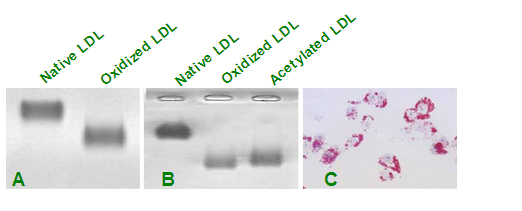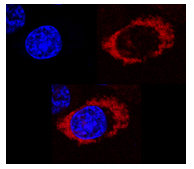人低密度脂蛋白(Human LDL)
产品名称: 人低密度脂蛋白(Human LDL)
英文名称: Human LDL
产品编号: SJ-001
产品价格: 0
产品产地: 咨询
品牌商标:
更新时间: null
使用范围: null
- 联系人 :
- 地址 : 广州市天河区珠村东丰工业园K栋205室
- 邮编 : 510000
- 所在区域 : 广东
- 电话 : 183****5253
- 传真 : 020-28067480
- 邮箱 : sojubio@aliyun.com
人低密度脂蛋白Human Low Density Lipoprotein (Human LDL)
LDL is a large protein (MW 3,500 kDa) with a diameter of 25.8 nm.It is composed of approximately 20-25% protein and 75-80% lipid. The lipid portion can be further described as 9% free cholesterol, 42% cholesteryl ester, 20-24% phospholipid, and 5% triglyceride.

SOju biotechnology LDL, is isolated from blood bank produced human plasma, via ultra-centrifugation (1.019-1.063g/cc). It is purified via ultracentrifugationto homogeneity determined by agarose gel electrophoresis.
Our LDL is membrane filtered and aseptically packaged. Store @ 4ºC.
氧化型低密度脂蛋白Oxidized Human LDL OxLDL
Our Human LDL is oxidized using Cu2SO4 (oxidant) in PBS. Oxidation is terminated by adding excess EDTA-Na2. Each lot is analyzed on agarose gel electrophoresis for migration versus LDL. This lot of OxLDL migrates 2.0fold further than the native LDL.

SOjubiotech Native-LDL(n-LDL), Acetylated-LDL(Ac-LDL) and Oxidized-LDL(ox-LDL) were loaded on a agarose gel and electrophoresed for 60 minutes. The lipoproteins were stained with Sudan Black(A and B). Oil red O stainning was used to determine the formation of foam cell. RAW264.7 were incubated with with 80μg/mL ox-LDL for 24hrs (C),
高氧化程度低密度脂蛋白High Oxidized LDL (High OxLDL)
Human LDL is oxidized extensively oxidized with Cu2SO4 (oxidant) in PBS at 37°C. It is used to induce cell apoptosis/death and cell injure. More detail about this product is available by sending a e-mail to: sojubio@aliyun.com
乙酰化低密度脂蛋白Acetylated Low Density Lipoprotein(Ac-LDL)
LDL is acetylated with acetic anhydride and dialyzed. It is ultrafiltered through a membrane and packaged aseptically under nitrogen.
DiI标记氧化型低密度脂蛋白DiI-Ox-LDL

Representive confocal images of suptake of DiI-ox-LDL in macrop-
hages from ApoE knockout mice.
oxidized Low Density Lipoprotein, labeled with 1,1’-dioctadecyl – 3,3,3’,3’-tetramethyl-indocarbocyanine perchlorate, which is highly fluorescent lipophilic dyes that diffuse into the hydrophobic portion of the LDL complex without affecting the LDL-specific binding of the apoprotein. DiI-Ox-LDL is used to label both vascular endothelial cells and macrophages. It can be used to identify and/or isolate these cells from mixed cell populations and investigate uptake and binding of modified LDL by different cell types. DiI has been excited at 488nm or 514nm and the emission is detected at 565 nm.
DiI标记乙酰化低密度脂蛋白DiI-Ac-LDL

Confocal images indicate
binding of DiI-Ac-LDL in
macrophages membrance
Acetylated Low Density Lipoprotein, labeled with 1,1’-dioctadecyl – 3,3,3’,3’-tetramethyl-indocarbocyanine perchlorate(see DiI-Ox-LDL ). modified low-density lipoprotein (LDL) including Ox-LDL, Ac-LDL can bind to cell membrance via class A scavenger receptor (SR-A) , CD36 and LOX-1 etc. When cells are labeled with DiI-Ac-LDL, the lipoprotein is degraded by lysosomal enzymes and the DiI (fluorescent probe) accumulates in the intracellular membranes. It can be used to quantify uptake of modified LDL. It also be used to identify isolated cells including vascular endothelial cells, macrophages, and endothelial progenitor cells(EPC).
DiI标记低密度脂蛋白DiI-LDL
Low Density Lipoprotein labeled with 1,1’-dioctadecyl – 3,3,3’,3’-tetramethyl-indocarbocyanine perchlorate(see DiI-Ox-LDL ).
高密度脂蛋白Human High Density Lipoprotein, HDL
Human High Density Lipoprotein, HDL, (Cat. No. YB-003) is isolated from blood bank produced human plasma. It is purified via ultracentrifugation (d=1.063 ~1.21 g/mL) to homogeneity determined by agarose gel electrophoresis.
极低密度脂蛋白VLDL
VLDL (d= <1.006 g/mL) is isolated from human plasma by ultracentrifugation. The purified VLDL is ultrafiltered through a membrane and packaged aseptically under nitrogen.
